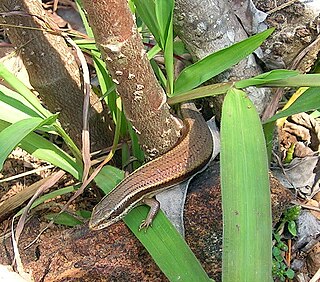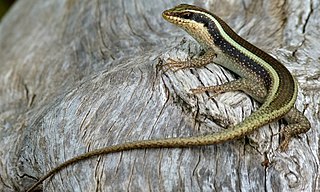Euprepis is an obsolete genus of skinks in the subfamily Lygosominae. It was named by Wagler in 1830 and frequently used in subsequent years, often misspelled as Euprepes, a misspelling introduced by Wiegmann in 1834. It was then subsumed under the large skink genus Mabuya, until Mausfeld and others resurrected it for a group of mainly African skinks they split from Mabuya. The following year, Bauer argued that this assignment had been in error and that this group should be called Trachylepis instead. Euprepis itself is a junior synonym of Mabuya.

Mabuya is a genus of long-tailed skinks restricted to species from various Caribbean islands. They are primarily carnivorous, though many are omnivorous. The genus is viviparous, having a highly evolved placenta that resembles that of eutherian mammals. Formerly, many Old World species were placed here, as Mabuya was a kind of "wastebasket taxon". These Old World species are now placed in the genera Chioninia, Eutropis, and Trachylepis. Under the older classification, the New World species were referred to as "American mabuyas", and now include the genera Alinea, Aspronema, Brasiliscincus, Capitellum, Maracaiba, Marisora, Varzea, and Copeoglossum.

Trachylepis is a skink genus in the subfamily Lygosominae found mainly in Africa. Its members were formerly included in the "wastebin taxon" Mabuya, and for some time in Euprepis. As defined today, Trachylepis contains the clade of Afro-Malagasy mabuyas. The genus also contains a species from the Brazilian island of Fernando de Noronha, T. atlantica, and may occur in mainland South America with Trachylepis tschudii and Trachylepis maculata, both poorly known and enigmatic. The ancestors of T. atlantica are believed to have rafted across the Atlantic from Africa during the last 9 million years.

Lygosominae is the largest subfamily of skinks in the family Scincidae. The subfamily can be divided into a number of genus groups. If the rarely used taxonomic rank of infrafamily is employed, the genus groups would be designated as such, but such a move would require a formal description according to the ICZN standards.
Rainbow skink may refer to:

Known as the rainbow mabuya, rainbow skink, pearly skink or blue-tailed skink, Trachylepis margaritifera, is a species of Afro-Malagasy mabuya or skink in the subfamily Lygosominae.
The name five-lined skink can refer to different species of skinks:

The African striped skink, commonly called the striped skink, is a species of lizard in the skink family (Scincidae). The species is widespread in East Africa and Southern Africa. It is not a close relation to the Australian striped skink, Ctenotus taeniolatus.

The Five-lined mabuya, sometimes called rainbow mabuya, blue-tailed skink or rainbow skink is a species of African skink in the subfamily Lygosominae. T. margaritifera is also known as the rainbow skink.

The Noronha skink is a species of skink from the island of Fernando de Noronha off northeastern Brazil. It is covered with dark and light spots on the upperparts and is usually about 7 to 10 cm in length. The tail is long and muscular, but breaks off easily. Very common throughout Fernando de Noronha, it is an opportunistic feeder, eating both insects and plant material, including nectar from the Erythrina velutina tree, as well as other material ranging from cookie crumbs to eggs of its own species. Introduced predators such as feral cats prey on it and several parasitic worms infect it.

Trachylepis maculata, the spotted mabuya, is a species of skink in the genus Trachylepis recorded from Demerara in Guyana, northern South America. It is placed in the genus Trachylepis, which is otherwise mostly restricted to Africa, and its type locality may be in error. It is an unstriped, olive-brown, grayish animal, with dark spots all over the body. Its taxonomic history is complex due to confusion with Trachylepis atlantica from the Atlantic Ocean island of Fernando de Noronha and doubts regarding its type locality.
Trachylepis tschudii is an enigmatic skink, purportedly from Peru. First described in 1845 on the basis of a single specimen, it may be the same as the Noronha skink (T. atlantica) from Fernando de Noronha, off northeastern Brazil. T. tschudii represents one of two doubtful records of the otherwise African genus Trachylepis on mainland South America; the other is T. maculata from Guyana.
Mabouya punctatissima is a skink described in 1874 on the basis of a single specimen. It was said to be from South Africa, but later researchers doubted that origin and aligned the species with the Noronha skink from Fernando de Noronha, off northeastern Brazil, instead. It is morphologically different from that species, however, and is currently placed in the genus Trachylepis as a species of uncertain identity.

Trachylepis homalocephala, commonly known as the red-sided skink, is a small, slender species of skink in the subfamily Mabuyinae.
Blue-tailed skink may refer to:
Trachylepis ferrarai is a species of skink, a lizard in the family Scincidae. The species is endemic to Somalia.

Trachylepis maculilabris is a species of skink. Commonly referred to as the speckle-lipped skink or speckle-lipped mabuya. It can be found in West Africa.
Bayão’s skink, Bayon's mabuya, or Bayon’s skink is a species of skink, a lizard in the family Scincidae. The species is endemic to Africa.
Trachylepis rodenburgi is a species of skink, a lizard in the family Scincidae. The species is endemic to West Africa.

Trachylepis punctatissima, commonly called the montane speckled skink, is a lizard in the skink family (Scincidae) which is widespread in southern Africa. The common and adaptable species occurs in a variety of habitat types at middle to high altitudes. It was for a time treated as a southern race of the African striped skink, T. striata.










